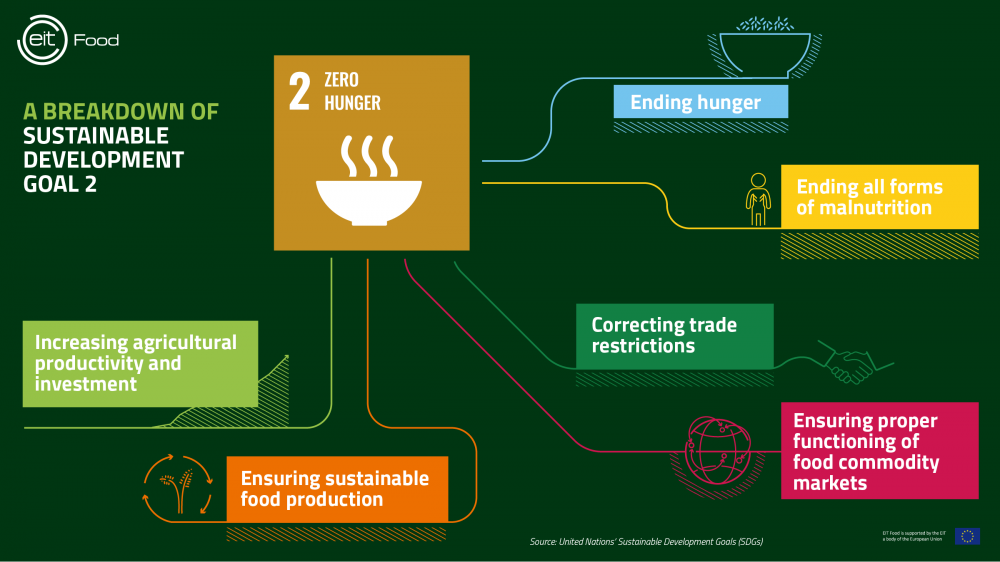Can the food sector combat food insecurity and malnutrition?
In order to meet the Sustainable Development Goal of ending hunger, malnutrition and food insecurity, the food sector must come together to fairly and sustainably find a solution.

Global hunger and food insecurity are on the rise. Estimates suggest that almost 820 million people are hungry (1) and close to 750 million people are affected by severe food insecurity (2).
Food insecurity is the state of living without reliable access to affordable, nutritious food, often impacting diet quality and leading to undernutrition as well as obesity. It is estimated that approximately 100 million people in the Europe and Central Asia region are exposed to moderate or severe food insecurity (3) and over half of European adults are overweight or obese (4).
The risk of malnutrition and food insecurity
Women, infants, children and adolescents are at particular risk of malnutrition (5) which can lead to long-term impacts such as changes to emotional responses in children, learning disabilities and issues with fertility in women.
Good nutrition is also considered vital for academic performance and productivity, and therefore integral to the development of global economies. In fact, it is estimated that every US$1 invested in tackling undernutrition in low- to middle-income countries yields an average of US$18 in socioeconomic return (6).
The COVID-19 crisis is expected to compound the global challenge of malnutrition and food insecurity. It is predicted that the pandemic will add between 83 and 132 million people to the total number of undernourished in the world in 2020, depending on the rate of the economic recovery (2).
This is likely due to the disruptions experienced in domestic food supply chains as a result of the pandemic, impacting global food prices thanks to changes in demand. What’s more, COVID-19 has already caused a 9% increase of unemployment in the EU (7) and losses of incomes. This could mean that those already food insecure are now facing even further negative impacts.
The Food and Agriculture Organization of the United Nations (FAO): The State of Food Security and Nutrition in the World 2020
Although food prices started to bounce back from the pandemic and rise again in June 2020 (8), countries across the world experienced fluctuations of food price inflation at the retail level. This could have caused knock-on effects along the food supply chain, such as households being forced to cut down on the quantity and quality of what they’re eating, potentially leading to lasting impacts on nutrition and health.
To make things worse, despite the increasing rates of global hunger and food insecurity, one-third of food produced for human consumption is lost or wasted (9).
In developing countries, 40% of losses occur during harvest (9) due to issues such as climatic conditions, improper handling and challenges related to marketing produce such as ‘ugly vegetables’ (10). It can also occur in storage or during transit due to inadequate facilities and human error.
Conversely, 40% of food loss and waste occurs at the retail or consumer level in industrialised countries (9) due to factors such as limited retail shelf lives, consumer purchase patterns and attitudes to waste.
Cutting these wastage rates by just a quarter could feed 870 million hungry people and, with food loss and waste accounting for approximately 8% of global greenhouse gas (GHG) emissions (9), prevent ongoing damage to the climate.
Planning for the future
The second of the United Nations’ 17 Sustainable Development Goals (SDGs) is to “end hunger, achieve food security and improved nutrition and promote sustainable agriculture” by 2030.

Central to these is the advancement of food research and innovation (R&I), specifically in the agrifood sector. EIT Food exists to drive innovation in the food sector as well as a deep transformation of how stakeholders, farmers, industries and consumers interact to shape and implement new ideas and solutions, together.
In order to meet SDG2, the FAO suggests (11) that governments and their development partners should adopt and implement a coherent set of measures to increase investment and accelerate action towards addressing:
- The primary and secondary causes that keep the hungry, food insecure and malnourished trapped in a cycle of deprivation
- Emerging trends and challenges, in order to ensure that the food and agricultural system provide consumers with access to sustainable, safe, nutritious and affordable foods (using consumer information, based on scientific evidence).
This is also mimicked in the European Farm to Fork Strategy where the European Commission lays out its plan to step up its coordination of a common European response to food security.
Drawing on lessons learned during the COVID-19 pandemic, the Commission will assess the resilience of the food system and develop a contingency plan for ensuring food supply and food security to be put in place in EU member states, particularly during times of crisis.
The Farm to Fork Strategy also states that ‘reversing the rise in overweight and obesity rates across the EU by 2030 is critical’ (12). It proposes a dietary shift to protein alternatives to red and processed meat with more fruits and vegetables to not only reduce malnutrition and life-threatening diseases, but also the environmental impact of the food system.
What is the role of the food sector?
Economic growth in agriculture is estimated to be two to three times more effective at reducing poverty and food insecurity than growth generated in other sectors (13). However, this must be done in a way that does not become detrimental to the environment. Investments and changes in the food sector should consider a balanced approach whereby food insecurity, malnutrition and sustainability are all weighted equally.
“To combat the scourge of food insecurity, many organisations in the public and private sector must play their role. The food industry should continue some of the great work that has been initiated during COVID-19 lockdowns to divert food that may have been wasted to feed those most in need. There will be a cost of industry and we need to have full transparency around the companies that are continuing to achieve this, those that have decided to reduce activities and those bad actors who decided it wasn’t in the best interests of their company."
“A multi-actor approach is needed, especially governments. It will also be very dependent on where in the world interventions are required. The developing and developed world need different approaches. However, what will be key is innovation, one of the major pillars of EIT Food.”
A potential solution is regenerative agriculture, a circular and climate-conscious farming method which has often proved to produce equal or higher yields for less cost than conventional farming in many cases.
EIT Food is driving positive change to transform the future of food together and reduce these global rates of food waste, food insecurity and hunger. By facilitating discussion and fast-tracking innovative agrifood entrepreneurs, our network and long term support plans are delivering scalable solutions that benefit the health of our people and planet. Learn more about how you can get involved here.
Further reading
- World Health Organization (WHO): The state of food security in the world in 2020
- World Economic Forum (WEF): Food security and why it matters
- Food and Agriculture Organization of the United Nations (FAO): Food losses and waste in the context of sustainable food systems
- Food Unfolded: EU Green Deal: 5 ways policy might impact our food system
Sources
- WHO: World hunger is still not going down after three years and obesity is still growing – UN report
- FAO: The state of food security and nutrition in the world 2020
- FAO: Low level of hunger but high prevalence of moderate food insecurity, overweight, and obesity in Europe and Central Asia
- WHO: The challenge of obesity - quick statistics
- WHO: Malnutrition
- John Hoddinott, Harold Alderman, Jere R. Behrman, Lawrence Haddad, Susan Horton, 2013: The economic rate for investing in stunting reduction
- FAO: FAO Food Price Index
- Statista: Unemployment rate forecasts in selected European countries from 2020 to 2021
- United Nations: International Day of Awareness on Food Loss and Waste Reduction
- The Independent: Ugly vegetables are a major cause of food waste
- FAO: Strengthening sector policies for better food security and nutrition results
- European Commission: The Farm to Fork Strategy
- International Fund for Agricultural Development (IFAD): Twelfth Replenishment. Recovery. Rebuilding. Resilience.
More blog posts


Farming in Europe: the changing landscape of food production







